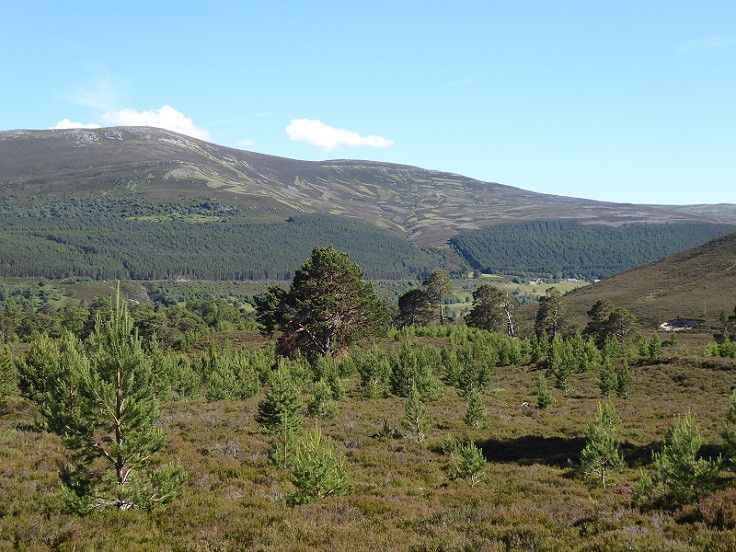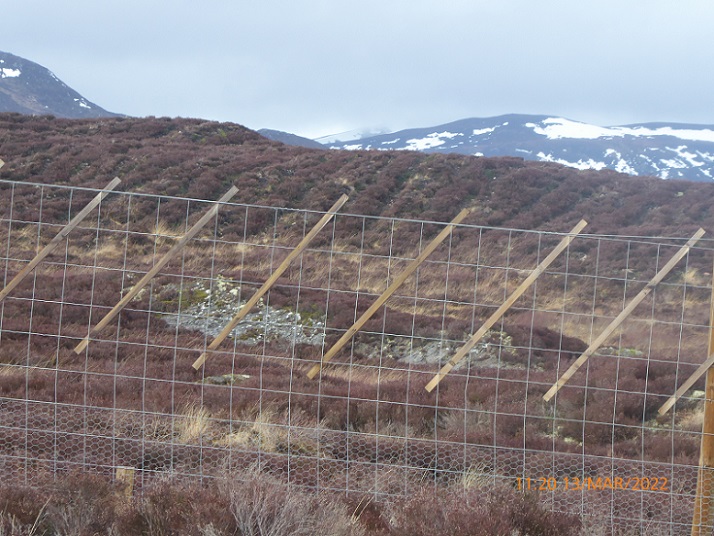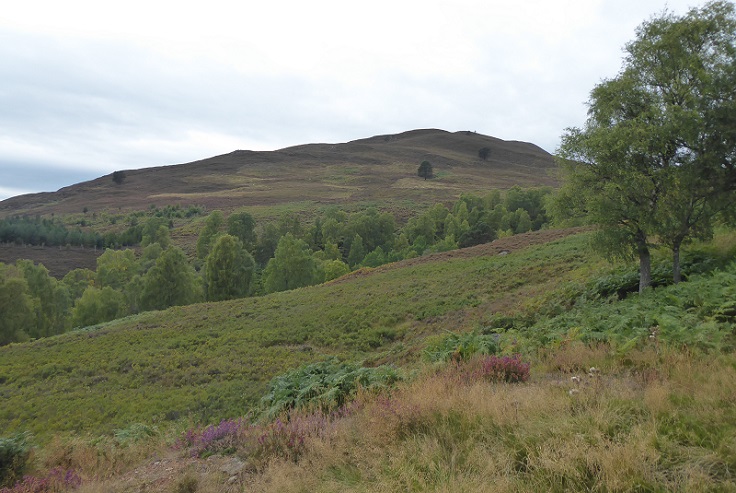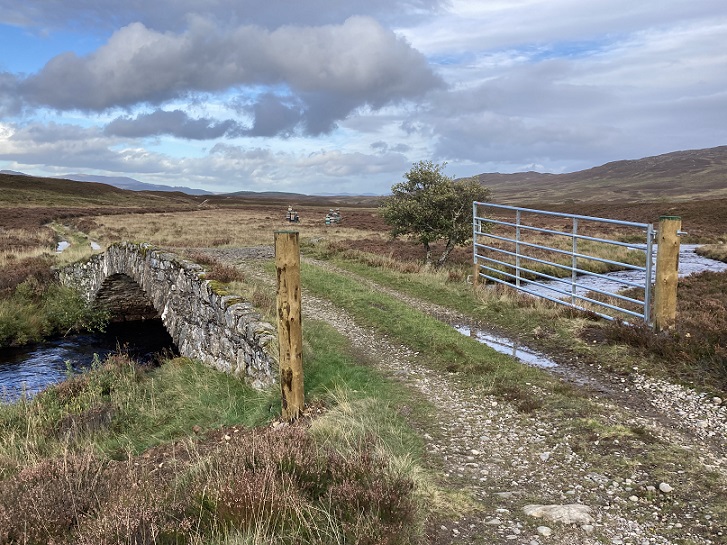
Writing in the magazine British Wildlife in August 2018 David Hetherington, ecologist with the Cairngorms National Park Authority, explained the importance of natural regeneration in expanding the existing remnants of the Old Caledonian pine forests in the Cairngorms. Natural regeneration is the key defining character of these forests, demonstrating that they are descended directly from the ancient forests which were established in Scotland following the last Ice Age, 9,000 years ago. Many scientific studies have highlighted their value, distinguishing the remnants of these forests from the planted Scots pine woodlands of more recent times.
But Hetherington explained that there was a problem in meeting the CNPA’s ambition and this problem was caused by the grant schemes put in place by successive governments to encourage forest expansion which were: “predicated on the installation of deer fencing and the planting of nursery-grown stock – a relatively expensive process reflected in high grant payments. Hetherington compared this to landscape reafforestation in Norway where woodland expansion had been achieved “cost free” across large tracts of western Norway in response to reduced grazing pressure. No deer fencing and no planting was needed in this part of Norway, demonstrating that over large tracts of Scotland the same could be achieved by simply reducing the grazing pressure from red deer, given the political will.
This post is the first of three which demonstrates how the Scottish Government is wasting £millions of public money through the existing forestry grant system in the Cairngorms and elsewhere. Other organisations, like the voluntary body Trees for Life, reinforce this system by also fencing and planting when they and their neighbours should instead be securing woodland expansion, at a landscape scale, by robust culling of deer without fencing.

Add to this the RSPB who insist on planting willows in the heart of the wildest part of the Cairngorms and it becomes obvious that a significant change in land use policy and practice is needed in Scotland, along with the financial incentives that currently underpin the wrong sort of forestry. Proper control of red deer numbers is central to resolving these problems but past evidence suggests that our politicians have no idea how to do this.
In Sept 2018 I wrote to Peter Argyle, then Convener of the CNPA, with a copy to all his Board members, as follows:
Dear Peter,
I have read the papers on the Forest Management Strategy which have been prepared for the Board meeting on 28 September and would like to bring to your attention one particular issue that concerns me. Overall I think this is an excellent strategy document which accurately reflects the heritage, land management and public enjoyment values for which the Cairngorms are famous. Those involved in its preparation are to be congratulated for the detailed analysis of the issues under consideration and for the proposed policies that arise from that analysis.
My main concern is that I do not think that a key part of the Forest Strategy, namely the aspirations for native woodland expansion, can be met in the way intended by the CNPA. These aspirations cannot be delivered effectively because of existing Forestry Commission Scotland grant aid policy. The main evidence for this comes from the Park’s own ecologist, David Hetherington, in a recently published paper (“Conservation of mountain woodland in the Cairngorms National Park”, British Wildlife, August 2018). I attach a copy. On page 397 is an explanation of the application of FCS grant aid policies in the Cairngorms followed by the statement that “woodland creation using the enhanced funding of the Forestry Grant Scheme is largely predicated on the installation of deer fencing and the planting of nursery-grown stock”.
This Forestry Grant Scheme is the only source of funding mentioned in the CNPA Forestry Strategy and is the primary means of financial support available to private landowners who have decided to support the Forest Strategy aspirations. As most landowners will only consider native woodland expansion if public funds are available to support such action, the overwhelming majority are likely to want to fence and plant in order to satisfy FCS grant aid requirements. This will be directly contrary to the CNPA aspirations in those areas of the Park where it wants to “encourage natural regeneration of native forests” (Strategic Objective No.4) and where it seeks to minimise the use of deer fencing in sensitive areas (Policy Guidance – woodland creation). While the FCS grant aid requirements may be appropriate in large parts of the target areas for forest expansion, notably where planting is a primary method of woodland establishment, they are not appropriate over perhaps even larger parts of the Park, especially where native woodland remnants remain and are capable of expansion through natural regeneration.
Hetherington’s paper also points to the serious cost implications of the FCS approach and compares the Scottish situation with Norwegian experience, describing the fencing and planting option as “a relatively expensive process reflected in high grant payments, such as £3,600 per hectare for the Native Scots Pine or Native Broadleaves options, plus £9.90 per metre of deer fence”. In Norway, by contrast, Hetherington explains that landscape-scale reafforestation has been achieved “cost free” in response to reduced grazing pressure. These remarks clearly point to a situation which is likely to give considerable concern to those responsible for approving public funding expenditure in the Park. Using the FCS approach over extensive areas would imply very poor value for money outcomes, irrespective of other concerns relating to heritage and public enjoyment values.
My own experience in dealing with FCS schemes in the Cairngorms is similar to the problems described by Hetherington – efforts to persuade landowners to prioritise natural regeneration when expanding the ancient woodlands have been too often compromised by the fencing and planting constraints of FCS grant aid. And from the Norway perspective, from many journeys through that country, I would say it is obvious, if we are serious about landscape scale ecological restoration in the Cairngorms, then the absolute priority is the need to cut down grazing pressures in and around our native woodland remnants, without any requirement for fencing and planting.
So I hope your Board members, at their meeting this week, will at least recognise that there is a really serious problem here with the way in which the FCS Grant Schemes are likely to be applied in the Cairngorms in response to the CNPA’s Forest Strategy. A way needs to be found to restrict the application of FCS grant aid so that it is only available in areas of the Cairngorms where ancient woodlands are absent. Where such woodlands are present new financial support mechanisms are needed to encourage private owners to promote their natural regeneration. Such support could come through other public bodies such as Scottish Natural Heritage, local authorities or the CNPA itself, with a focus on reducing grazing pressures. I hope the Board will give its attention to the need to make such changes as soon as possible. If I can be of any further assistance on this matter please let me know.
I have copied this email to Grant Moir and the relevant CNPA staff and also to all Board members whose email addresses appear on the CNPA website. I will ask Alix Harkness to copy my email on to those email addresses that are not on the website.
All the best
Dave
————–
So far, over 4 years later, I have received no reply to this communication, but I did hear that, at the subsequent Board meeting, one member asked “what are we going to do about Dave Morris’s letter”.
“Nothing” would appear to be the answer.

Today we can see the consequences of such non CNPA action. BrewDog, the craft brewing company, have been awarded in excess of £1million, from Scottish Forestry (SF), to fence and plant a large part of their Kinrara estate, near Aviemore. This ludicrous scheme has been approved despite plenty of representation to SF and BrewDog’s advisers to explain that, as Kinrara is adjacent to one of the best remnants of the Old Caledonian forest, the Dulnain native pinewood, fencing and planting is completely unnecessary. The essence of this advice was that, so long as no further heather burning took place and effective deer culling measures were carried out, then natural regeneration of trees, shrubs, mosses and lichens etc would be extensive, throughout the estate.

Further south in Badenoch Standard Life Investments Property Income Trust have bought a large part of Ralia estate near Newtonmore (see here), rejoicing in the prospect that the taxpayer will be generously footing a good part of the bill. In this case, representations against the new deer fencing that was proposed in the original plans appears to may have had some impact.. Most of the adjacent ground is owned by Anders Polvsen and his Wildland company. They have demonstrated in Glen Feshie, Gaick and Tromie how to restore natural forest ecosystems without deer fencing and planting. Clearly no fencing should ever have been considered along the boundary between the two estates and we understand this may now have been removed from the plans, but the consultants are still proposing to use machines to plant trees. SLIPIT should simply stop burning the moorland, block all the artificial drains in the wet areas and cull the deer, following the example of their neighbours.

Sadly SLIPIT’s most ostensible action so far has been to damage an ancient Wade Bridge by a fence and gate erected in the wrong location while they have recently published hill track development proposals which appear to be completely unnecessary.
In the following posts I will explain why the existing Scottish forestry grant system should be terminated asap and a completely new type of financial incentive put in place to support tree planting in the lowlands rather than the uplands and why public money is no longer needed to support planting in the uplands.

I find a number of problems with currrent practices too. Around Alford on Donside where I live you can see them . Companies entering the schemes whereby they plant trees to fix carbon are buying up farms at prices no farmer could afford if they were simply farming the land. Enter companies and their workforce with no local relationships or knowledge. Extensive deerfencing systems are erected in areas where there are no red deer at all. They are erected to exclude roe deer their planters tell me. Apart from the fact that I know of no situation where browsing by roe deer, which can be a hazard as on plantings I have put it on our land, can actually stimy whole plantings, there is another small problem. How did they exclude roe deer when they erected the fences over whole hillsides? Anyone who has experienced roe deer’s well known capacity to hide within yards of you even as you know they are there and look for them knows you can’t really clear them out of large areas and what they have done is enclosed roe deer populations within their fencing. At the same time the company’s schemes fence off old rights of way that connected communities or access to the hill.
Kildrummy Estate on Donside has been bought by and American for his son who is not interested in shooting etc but in wildlfe, carbon fixation, river restoration etc. Major culling of red deer has taken place (Two tenants we know climbed the hill above their house and counted 600 red deer). Very large scale planting (lots of broadleaves etc) and fencing have gone in but, if money is no object as in this situation, why not just cull the red deer more and let the forest regenerate?
Remember of course that all the farmers are getting substantial grants to farm (or not farm) so “pots and kettles” come to mind….
Deer fencing can also have the effect of reducing access to high ground. The local Access Trust proposed that gates be provided in the fence, at or close to the end of new forest tracks, in the proposed forest planting above Shandon (on the Gareloch). The fairly minimal cost to open up the Fruin ridge was regarded as too high; grants would have been required
I agree that natural regeneration through herbivore management is the best way to expand native woodland. The conservation landowners in The Cairngorm agree with that too, however, they all plant trees to some extent for various ecologically justified reasons. Wildlands Ltd have planted over 1.5million trees in and around Glen Tromie so your use of Glen Tromie as an example of how to restore natural forest ecosystems without planting is not a good one. NTS at Mar Lodge have planted thousands of trees (and willows in remote mountain areas, like RSPB) and have plans to plant thousands more. I agree the grant schemes could be redesigned to be more supportive of natural regeneration but note that there is funding available through the Woodland Grant Scheme for deer management in native woodland (this can include open ground near to woodland) that pays £20 per hectare per year and funding for establishment of natural regeneration that pays £400 per hectare once established. Let me know if you would like me to find links to these options on the SF website.
Most of the planting on Wildland Estates has been carried out in the river catchments between Glen Tromie and Glen Feshie where there was no remnant natural forest. I am in favour of such planting providing it is carried out without the use of deer fencing and with minimum soil disturbance, preferably focussed on mineral, not peaty soil. To achieve this across the uplands of Scotland a massive cull of red deer herds is needed. Better to employ hundreds more stalkers and stop heather burning than wasting public money on deer fencing.
In all catchments where natural forest remnants are still present a natural regeneration only policy should apply, from the existing remnant to the altitudinal limit for tree growth. Existing forestry grants usually only facilitate such expansion over a few hundred metres from the existing remnant, which is hopeless when the ecological requirement is for the steady expansion of trees, shrubs and other species to the altitudinal limits.
The existing forestry grant scheme, with its focus on planting and fencing, was designed to keep landowners happy, providing them with lots of public subsidy to do patchwork planting leaving all the rest of the hill ground in a degraded condition, with excessive numbers of red deer available for sporting use. This has to stop NOW, if we are serious about a climate and biodiversity emergency.
Prof Dieter Helm, former chair of the UK government’s Natural Capital Committee, described the primary future purpose of management of the Scottish uplands as “to capture carbon”. Sir David Attenborough, in his address to COP26, said “wherever we restore the wild, it will capture carbon and help us bring back balance to our planet”. This means we need to think about all species, not just trees, when restoring the uplands. From a public subsidy perspective that means a job for Nature Scot, not Scottish Forestry. Much of the money currently paid out in grant aid in the uplands by SF therefore needs to be transferred to NS. In the lowlands, which is the best place for growing trees for commercial timber purposes, the existing SF grant aid money should be transferred to the Agriculture Dept and used by them to support lowland planting by farmers, as part of the forthcoming new grant system that will replace Common Agricultural Policy payments.
The National Trust for Scotland has carried out far too much planting and fencing in areas where they should have been rewilding through natural regeneration. This is because they are excessively influenced by their near neighbours, the Royal Family, who continue to manage land in Deeside by traditional methods and set a very poor example to every other landowner in Scotland.
I was under the impression, that the land to be planted was from the upper reaches of the hill, visible behind the gate in the above photo ,and over to the east. I had not realised that land in the valley around Wade bridge would be involved.
Where can i access the proposed hill track developements ?
I have checked and as yet there has been no application for a Forestry Grant submitted to Scottish Forestry so it is not clear where the planting will be or where fences are proposed – I have initial plans for the scheme but understand they have been greatly revised. There is a prior Notification for a Forest Track – how can you have a track without a scheme? – on the Highland Council website which I hope to write a post about soon
Forest grant schemes are adaptions of commercial forestry grant schemes. They have a time limited objectifiable outcome. They are public funds so a tangible outcome is expected.
The problem comes about when we truly wish to rewild. The onus for success is placed on the applicant as though they have control over the forces of nature. There is no latitude for “suck it and see”.
Civil servants are incapable of funding against outcomes which are not SMART. In most cases this is a good thing. When it comes to rewilding will we be doing the forehead slap that we now do for the rape of the flow country and the destruction of peatlands. Will the state be paying to undo the mistakes created by past state funbing as it is doing now in Caithness ? In fifty yeras will we be asking why we couldn’t afford to.pay whatever it took to allow a ” natural” habitat to develop or will we simply say ” at least what they did was better than the industrial landholder dictated wasteland it replaced”.
Philosophy and public finance are fickle bedfellows. We need to learn to best guess the reaction of our future practitioners not the sensibilities of the voters at the next election.
And if anyone knows how to do that, I will stand them a bloody good bottle of malt !
50 and 60 years ago there were sensational stories locally in the press across West Lochaber after massive ploughs behind crawler tractors had ravaged hillsides and disrupted watercourses in west lochaber. Ring Deer fenced enclosures were then established by the Forestry commission prior to forest planting, all across Morvern and Ardnamurchan. Sitka spruce with forest fringes of larch, have today almost all been clear felled, leaving “battle fields” of destruction. The 1960’s press heard that Red Deer trapped within many newly fenced enclosures had been summarily slaughtered. In some place helicopters were employed. There was a public outcry. This method to control numbers of red deer was considered unsporting and inhumane. Later wiser council prevailed. Through the late 1970’s and early 80’s replanting without fencing was attempted in Glen Tarbert east of Strontian. Bundles of Seedling trees, Fir, Pine, and native broadleaf were carried up, or dropped by helicopter onto hillsides, then Teams went out on foot to ‘random plant’ glades on drier Ground. No machines were used at all. No fences were ever erected. Today, despite fairly constant presence year-round of deer, the scattered patch forest is re-established. Anyone viewing it from the A 861, would assume it was native old growth. I have a photo of this glen taken in the early 1960’s before road was widened to dual track as far as Strontian. This was before wartime flocks of hill sheep were removed. The contrast with today is remarkable. The secret was an acceptance with allowance made for a fairly high wastage among the small trees before they really established…but it was predicted that if in large enough numbers most trees would survive. They thrived far better than expected (even without plastic tree tubes!) Today, anyone who looks south of the main road will spot that. The lessons are there. Shame is, each new generation of professional Forester in Scotland appears willfully ignorant of mistakes made in previous decades. Why do ‘educators’ still fail to teach?
Very interesting perspective. I recently travelled across Morvern to and from Lochaline and observed some “battlefields of destruction” on areas of recent felling. I was astonished to see new deer fencing being erected once again around these same areas, no doubt at great cost to the public purse. Once again Scottish Forestry officials are touching their forelocks to the private landowners, allowing them to maintain excessive red deers herds for their sporting clients while the only trees that can grow are behind expensive fences. Deer fencing should be banned on Morvern, as in most of the rest of Scotland, with the powers available under the Deer (Scotland) Act 1996 finally used to control deer numbers effectively. Wake up Scottish Government and tell your officials to use the powers they have had for 25 years to stop this widespread ecological degradation of our finest landscapes, cull the deer and remove the fences.